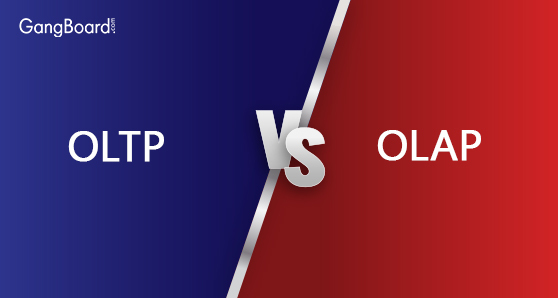
OLTP Vs OLAP
OLTP Vs OLAP
If you take IT systems into consideration, OLTP is transactional and OLAP is analytical. It simply means that OLTP feeds the system with data and OLAP analyses the data.
What is OLAP?
OLAP is a kind of software tool analyses data from multiple databases to streamline business decisions. OLAP is primarily based on data analysis. OLAP is prominently used when there is a need for a comparison of huge data. OLAP is capable of reporting to multidimensional analysis of data, like the queries on statistical, financial reporting etc. Allowing the users to view the results of queries before any kind of decision.
What are the Benefits of OLAP?
- A single platform is sufficient to assess and analyses multidimensional data.
- Maintains consistency in calculations and any information delivered.
- Easily imply security restrictions on users to protect sensitive data with respect to regulations imposed.
- Amassed as well as detailed data processing.
- Quick computation of data.
- Familiar business terms and expression to make interactions flawless.
- Even learning curve, as anyone with even nil IT background can work on it.
What are the flaws in OLAP?
- Requires complete dependency on IT personnel as the installation and maintenance require IT assistance.
- Pure modeling of OLAP tool is important; it does not facilitate any kind of immediate analysis.
- Lack of computational capability.
- Lacks Interactive analysis.
Examples of OLAP
Since OLAP is mostly used in the analysis, business profoundly uses it for evaluating a huge volume of data. Companies dealing with mobile phones sales use it to verify the sales differences happening in various months. OLAP can also be used where the amount of data is unprecedented.
OLAP can also analyses the purchase pattern of an individual and then design the homepage with clear specifications with respect to the individuals shopping pattern. Hence OLAP is a data warehouse system.
What is OLTP?
Online Transaction processing abbreviated as OLTP is based on day-to-day transactions. OLTP has used in 3-tier architecture transaction-oriented applications. OLTP deals with addition, updating and deletion operations in every transaction. Being simple and short, it is easier to use and process with OLTP.
OLTP uses normalized 3NF tables databases. A common example of OLTP is basically an ATM, which works on short and common data interactions.
What are the benefits of OLTP?
- Facilitate online processing
- Quick and fast response
- Easy and simple to use
- Offers transactional priority over data analysis
What are the drawbacks of OLTP?
- Handles only one request every time, multiple requests complicates.
- Unscheduled downtime, that disrupts transactions.
- As concurrency causes errors, data recovery is tedious.
- The disruption caused by hardware failures, induce changes and damage of data.
- Multi-access causes disruption of data.
Examples of OLTP
OLTP finds the usage with respect to the transactional data. When a dispute on a transaction occurs, OLTP processes only the transaction, where the verification is already done or established rather than the authenticity. Hence being a transactional superiority performance, it is commonly used in online banking, order entry, shopping cart addition, air ticket booking or even message sending an application.
Difference Between OLTP and OLAP
Factors
|
OLAP
|
OLTP
|
|
Data Base
|
Uses data warehouse as it can access multidimensional data. |
Uses traditional 3NF database.
|
|
Characteristics |
Uses a large volume of data. |
Consists of multiple transactions with a smaller volume of data. |
|
Process |
Are an online data retrieval and analysis process |
Is a transactional system and manage the modification to the database. |
|
Query |
It includes only select operations, which involves a combination. |
Most operations are based on Insert, Update and deletion of information from the database. Mostly very simple query types are used. |
|
Tables |
Not Normalized |
Normalized |
|
Source |
OLTP databases constitute the OLAP data source |
Various transactions become the source of data. |
|
Data Integrity
|
Since updating of data is limited, data integrity is never an issue |
Data integrity is a constraint.
|
|
Response Time |
Response time is almost a minute |
Response time in milliseconds |
|
Quality of Data
|
OLAP data is not organized
|
In OLTP the data adheres to quality
|
|
Use |
Planning, analysis, problem-solving as well as decision making |
Just work fundamental business tasks
|
|
Operations |
Mostly read operation |
Performs Read/Write operation |
|
Spectators |
Customer oriented |
Market-Oriented |
|
Back-up |
Back-up is required only time-to-time |
Backups are regular as well as incremental |
|
Design |
Data specific |
Industry specific |
|
Users |
Mostly for data understanding or for data mining users |
Mostly used by data critical users
|
|
Purpose
|
Mostly used for analytical purposes
|
Used in the case of real-time business
|
|
User number
|
Allows hundreds of users
|
Almost thousands
|
|
Performance
|
Query response time is the performance metric |
Transaction response is the performance metric. |
|
Productivity |
Augments business analyst’s productivity. |
Augments an individual users productivity. |
|
Major Challenge |
Being majorly in technical use, it is important to be technically sound |
Costly data warehouse built. |
|
Process speed |
Query results are quick. |
Quick response to daily data. |
|
Characteristic |
A view is depicted using a spreadsheet |
Simple to maintain. |
|
Design |
Designed to integrate with multiple data sources to bring in a consolidated database. |
Normalized, with low data dependency with the quick response time.
|
|
Insertion and updating |
Time-consuming batches of queries |
Short and quick insertions and deletions |


 +1 201-949-7520
+1 201-949-7520 +91-9707 240 250
+91-9707 240 250